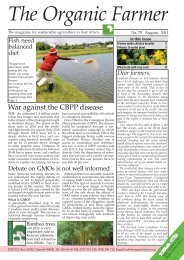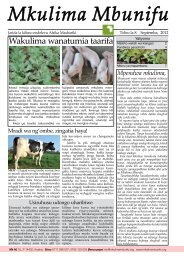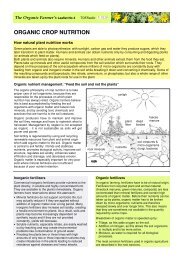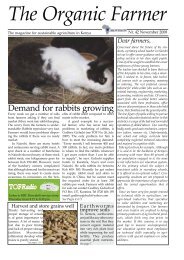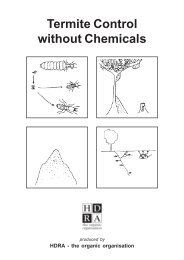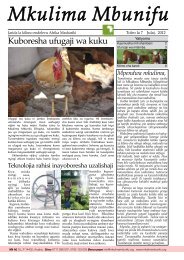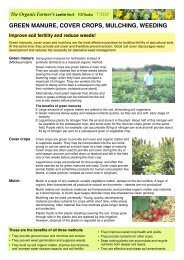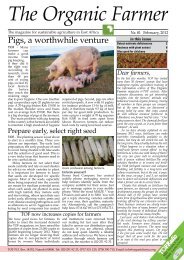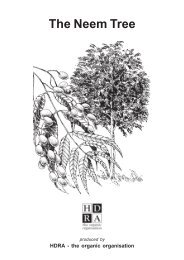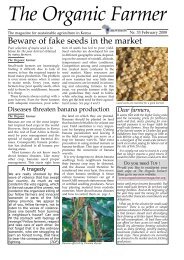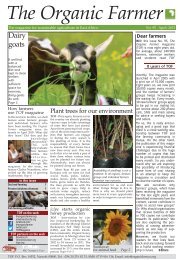Green manure is best fertilizer - Infonet-Biovision
Green manure is best fertilizer - Infonet-Biovision
Green manure is best fertilizer - Infonet-Biovision
Create successful ePaper yourself
Turn your PDF publications into a flip-book with our unique Google optimized e-Paper software.
Fruit flies cause great losses to mango<br />
farmers. Here are some methods to<br />
control these pests.<br />
Sunday Ekesi (ICIPE)*<br />
Mango production <strong>is</strong> continually<br />
gaining recognition for its potential as<br />
a major source of income, especially<br />
for smallholder farms. The total area<br />
under mango production in Kenya<br />
alone <strong>is</strong> estimated at 16,000 ha. Mango<br />
exports from Africa were estimated at<br />
35-40 thousand tonnes annually and<br />
worth around KSh 3 billion (US$ 42<br />
million). The EU remains the largest<br />
destination market for export from<br />
Africa.<br />
Three types of pests<br />
In each region where mango <strong>is</strong> grown,<br />
it <strong>is</strong> attacked by fruit flies of different<br />
types.<br />
• One of the major pests of the fruit fly<br />
family <strong>is</strong> Bactrocera invadens. In addition<br />
to mango (which <strong>is</strong> the primary<br />
host), the insect also attacks other cultivated<br />
fruits such as oranges, tomato,<br />
banana, guava, custard apple and<br />
avocado.<br />
• Another fruit fly <strong>is</strong> Ceratit<strong>is</strong> cosyra.<br />
In addition to mango, it also attacks<br />
guava, custard apple and marula.<br />
The insect gradually has been pushed<br />
away by other fruit fly species from<br />
the lowland areas, but they remain<br />
a threat to mango production in the<br />
highlands.<br />
• Third in terms of economic importance<br />
on mango are Ceratit<strong>is</strong> rosa and<br />
its close relative, Ceratit<strong>is</strong> fasciventr<strong>is</strong>.<br />
Apart from mango, they also attack<br />
a broad range of cultivated and wild<br />
fruits.<br />
Fruit flies cause direct losses to<br />
mango when the female fly lays her<br />
Nr. 27 August 2007<br />
Protect your mangoes against fruit flies<br />
Healthy Tommy mangoes (L). Infested mango fruit full of maggots(R).<br />
eggs under the skin of the mango<br />
fruit. The eggs hatch into whit<strong>is</strong>h<br />
maggots that feed in the decaying<br />
flesh of the fruit. Infested fruit quickly<br />
rot, causing considerable losses in<br />
production.<br />
In the past, yield loss on mangoes<br />
in Kenya, Tanzania and Uganda due<br />
to the indigenous fruit flies range<br />
between 30 to 70 percent, depending<br />
on the locality, season and variety.<br />
Th<strong>is</strong> problem became aggravated by<br />
the fairly recent introduction of Bactrocera<br />
invadens, and damage has now<br />
increased to between 40 to 80 percent,<br />
especially in lowland areas where it <strong>is</strong><br />
now the dominant fruit fly pest.<br />
Control methods<br />
There are several methods of controlling<br />
fruit flies. The approach that <strong>is</strong><br />
being promoted by ICIPE <strong>is</strong> to adopt a<br />
combination of methods by applying<br />
Integrated Pest Management (IPM)<br />
techniques.<br />
Baiting technique: The traditional<br />
method of fruit fly control <strong>is</strong> based<br />
on use of food baits. The bait attracts<br />
the fruit flies from a d<strong>is</strong>tance to the<br />
spot of application, where the flies<br />
feed on the bait, ingest the pesticide<br />
and die. The bait <strong>is</strong> normally applied<br />
to a 1 square meter (1 m²)spot on the<br />
canopy of each tree in the orchard on<br />
a weekly bas<strong>is</strong>, starting from when<br />
the fruits are about 1 cm in size<br />
and continues till the very end of<br />
the harvest. Several commercial baits<br />
are available in the market, such as<br />
NuLure, Buminal and Solbait, that<br />
can be mixed with pesticide such<br />
as Spinosad and applied as above.<br />
Another commercial product <strong>is</strong> GF-<br />
120 (Success). Th<strong>is</strong> bait <strong>is</strong> already<br />
pre-mixed with pesticide (Spinosad)<br />
(TOF / R. Copeland)<br />
Fruit flies: Ceratit<strong>is</strong> capitata mating<br />
Bactrocera invadens male enlarged 800<br />
times (Photos courtesy: Robert Copeland)<br />
and can be applied using the on-label<br />
information on the container.<br />
Major problems in the use of baits<br />
in Africa <strong>is</strong> that they are expensive<br />
and inaccessible to a large number of<br />
fruit growers. Research at ICIPE has<br />
shown that a protein bait from brewer’s<br />
yeast obtained as an industrial<br />
by-product provides good control<br />
of mango infesting fruit flies when<br />
applied in low volumes as spot spray<br />
to 1 m² of mango canopy or to the<br />
mango trunk. Research <strong>is</strong> continuing<br />
to formulate the bait to enhance its<br />
attractiveness to fruit flies. The new<br />
bait should be available as an alternative<br />
to imported products in the very<br />
near future.<br />
Soil inoculation: During development,<br />
mature maggots of fruit flies<br />
drop from the fruits to the ground,<br />
burrow into the soil and form a<br />
resting stage called the puparia. An<br />
important part of fruit fly suppression<br />
research at ICIPE includes soil treatment<br />
with a fungal pathogen to kill<br />
the mature maggot and puparia. The<br />
active ingredient in the granules <strong>is</strong> a<br />
fungus called Metarhizium an<strong>is</strong>opliae,<br />
a naturally occurring fungus that <strong>is</strong><br />
used worldwide as a biological pesticide<br />
for controlling different kinds of<br />
insect pests. The fungus <strong>is</strong> formulated<br />
as granules and can be manually d<strong>is</strong>tributed<br />
by hand and then raked into<br />
the soil under the mango canopy.<br />
Application <strong>is</strong> usually done once in<br />
continued on page 5<br />
Con



